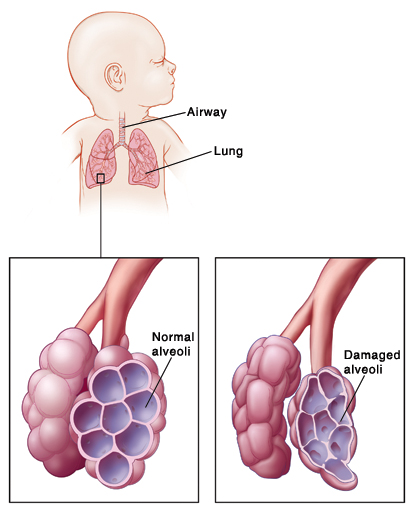Bronchopulmonary Dysplasia in the Premature Infant
Bronchopulmonary dysplasia (BPD) is a lung disorder that causes breathing problems in preterm, low-birthweight babies who need help breathing. Health care providers usually care for babies with BPD in the neonatal intensive care unit (NICU) or the pediatric intensive care unit (PICU). Over time, the damaged lungs can heal. The baby grows new lung tissue.

What causes BPD?
BPD sometimes occurs in babies who need life-saving help with a breathing machine (ventilator) for long periods. In some cases, this breathing help can lead to long-term problems. Other causes of BPD include:
-
Prenatal infections.
-
Maternal problems such as smoking or drug use.
-
Problems with the placenta.
-
Inflammation of the fetal lungs before birth. This may be caused by a maternal infection.
-
Pregnancy-induced hypertension (preeclampsia).
NICU staff takes steps to prevent problems caused by a ventilator and by giving extra oxygen. But sometimes they can’t prevent them. BPD occurs when scarring affects a baby's air sacs (alveoli) and the airways inside the lungs.
Scar tissue doesn’t work like normal lung tissue. So babies with BPD have a hard time breathing. They tend to breathe hard and fast while at rest. They may also wheeze or become short of breath. This can get worse if the baby has a cold or is exposed to lung irritants, such as cigarette smoke.
How is BPD treated?
-
Medicine. Certain medicines, called bronchodilators, help open narrow airways. Diuretics help remove excess fluid from lungs. In rare cases, steroids are used to control inflammation and swelling inside the airways.
-
Chest physiotherapy. This helps clear fluid and mucus from the lungs. The nurse or respiratory therapist may first loosen mucus by tapping or vibrating the baby’s chest or back. Changing the baby’s position can also help mucus find its way out of the smaller airways. Suction may be done in the baby’s endotracheal tube if the baby is still on a breathing machine. A health care provider may teach you to help with chest physiotherapy.
-
Treating other health problems. Babies with BPD may have other health problems. BPD does not cause these. But some health problems, such as infections, can make BPD worse. Treating them may help your baby recover from BPD more quickly.
-
Caring for your baby’s overall health. Reducing stress and stimulation can help calm babies. This makes breathing easier. Keep up to date on all vaccinations. Babies with BPD are especially at risk of viral infections.
-
Extra nutrition. Babies with BPD need extra food to gain weight. This is because they are working hard and using a lot of energy to breathe.
-
Ventilation. The amount of breathing help depends on how bad BPD is. Some babies may only need extra oxygen, while others need a ventilator. This is slowly phased out as lung function improves.
-
Surfactant replacement therapy. Surfactant helps hold the air sacs in the lungs open. Preterm babies and babies born with other health problems may not produce enough surfactant. Your health care provider will discuss the possible risks and benefits of this therapy.
What are the long-term effects?
Many babies with BPD recover quickly. These babies often go home shortly after they are born. But in more severe cases, babies with BPD may need long treatment in the NICU or PICU. When the baby does go home, they may still need medicine. They may also need a ventilator or extra oxygen. These more severe cases of BPD can cause delays with brain development and other problems. They can also lead to chronic lung disease, such as asthma. Babies with BPD may also develop other problems such as high blood pressure, vision and hearing problems, and heart problems.
Severe cases of BPD can put great emotional, physical, and financial stress on parents and other family members. Ask health care providers for resources that can help you and your family care for your baby and yourselves.
Online Medical Reviewer:
Daphne Pierce-Smith RN MSN
Online Medical Reviewer:
Tracy C. Garrett RNC-NIC BSN
Online Medical Reviewer:
Vinita Wadhawan Researcher
Date Last Reviewed:
4/1/2025
© 2000-2025 The StayWell Company, LLC. All rights reserved. This information is not intended as a substitute for professional medical care. Always follow your healthcare professional's instructions.